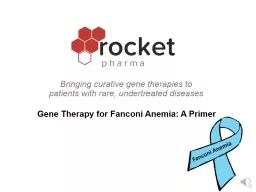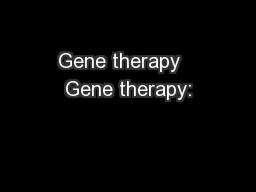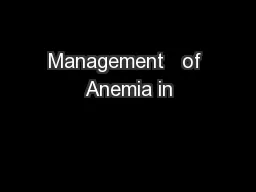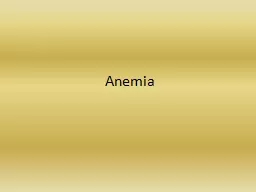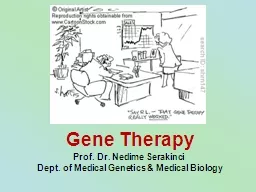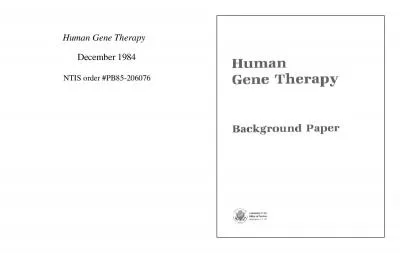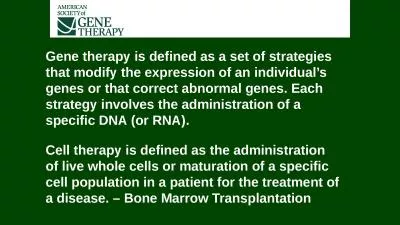PPT-Gene Therapy for Fanconi Anemia: A Primer
Author : haroublo | Published Date : 2020-06-16
1 Fanconi Anemia What is Fanconi Anemia FA 2 DNA damage Eventual cell death FA Cell Healthy Cell DNA damage Production of more healthy cells Repairs itself When
Presentation Embed Code
Download Presentation
Download Presentation The PPT/PDF document "Gene Therapy for Fanconi Anemia: A Prime..." is the property of its rightful owner. Permission is granted to download and print the materials on this website for personal, non-commercial use only, and to display it on your personal computer provided you do not modify the materials and that you retain all copyright notices contained in the materials. By downloading content from our website, you accept the terms of this agreement.
Gene Therapy for Fanconi Anemia: A Primer: Transcript
1 Fanconi Anemia What is Fanconi Anemia FA 2 DNA damage Eventual cell death FA Cell Healthy Cell DNA damage Production of more healthy cells Repairs itself When this occurs in bone marrow BM cells for example it leads to BMF or leukemia. INTRODUCTION. Most developments in biotechnology originated for their potential applications in health care.. Contribution of biotechnology:. Diagnosis of diseases. Therapeutic agents. Correction of genetic disease-Gene therapy. to correct a . genetic defect . by transferring of a . functional normal copy. of the gene into cells. Examples of diseases caused by genetic defect. Ornithine . transcarbamylase. (OTC deficiency). CKD . Patients. 2012 KDIGO . Update. Dr. . Shahram. . Taheri. . CKD is a worldwide public health issue. . The incidence and prevalence of kidney failure are increasing, outcomes are poor, and the cost is high. . By Kole Drumheller and Austin Dillard. Gene Therapy. What is Gene therapy?. This is a technique that is designed to introduce new genetic material into cells to help fix abnormal genes or to make a new protein that will help the person.. Kyle Orwig. Magee-. Womens. Research Institute. University of Pittsburgh School of Medicine. International Summit on Human Gene Editing:. A Global Discussion. December 1-3, 2015. Stem Cell. Renewal. . SYFTET. Göteborgs universitet ska skapa en modern, lättanvänd och . effektiv webbmiljö med fokus på användarnas förväntningar.. 1. ETT UNIVERSITET – EN GEMENSAM WEBB. Innehåll som är intressant för de prioriterade målgrupperna samlas på ett ställe till exempel:. referance. range for the age and sex. The normal ranges vary with age . -neonate < 14g/dl. -1-12mths < 10mg/dl. -1-12y< 11 g/dl. Causes of anemia can be from. Reduced cell production. Increased destruction. Dept. of Medical Genetics & Medical Biology. Gene Therapy cartoon 10 - search ID shrn157. . . Gene Therapy cartoon 5 - search ID shrn147. . . Purpose of. gene therapy:. Management and correction of human diseases. 6000. inherited human diseases catalogued to date, only a few are currently treatable.. Gene therapy. —introducing functional copies of a gene into an individual with two defective copies of the gene—is a potential tool for treating inherited human diseases.. This kind of study was conducted �rst time in Pakistan. Its objective was to ascertain the associated clinical features and analyze the FANCA exon 28 and exon 29 mutations in Pakistani Fanc December 1984 NTIS order #PB85-206076 “Where two principles really do meet which cannot be reconciled with one another, theneach man declares the other a fool and heretic. ” –Ludwig Wit Automotive primer helps to prevent corrosion, covers imperfections, and ensures a professional and long-lasting paint finish. Read more! Cell therapy is defined as the administration of live whole cells or maturation of a specific cell population in a patient for the treatment of a disease. . – Bone Marrow Transplantation. Bone . Marrow Transplantation for DBA. Starter: Comparing DNA processes. Process. What does it do?. How does it work?. PCR (Polymerase Chain. Reaction). DNA Sequencing. DNA Profiling. Gel Electrophoresis. Process. What does it do?. How does it work?.
Download Document
Here is the link to download the presentation.
"Gene Therapy for Fanconi Anemia: A Primer"The content belongs to its owner. You may download and print it for personal use, without modification, and keep all copyright notices. By downloading, you agree to these terms.
Related Documents

